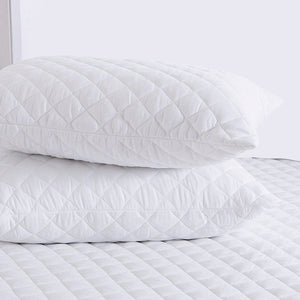How Many Pillows Should You Sleep With?
Sleep is a fundamental aspect of our daily lives, and the quality of our sleep can significantly impact our overall well-being. One overlooked factor contributing to a good night's sleep is the number and type of pillows we use. The question of how many pillows one should sleep with may seem trivial, but it plays a crucial role in ensuring comfort and proper spinal alignment. This comprehensive guide will explore the optimal number of pillows for various sleeping styles and delve into other essential considerations to help you achieve the best sleep possible.
How Many Pillows Should Side Sleepers Use?
Side sleeping is common, and choosing the correct number of pillows is essential for maintaining proper spinal alignment. Experts recommend using one firm pillow to support the head and neck while placing another between the knees. This extra pillow helps align the hips and reduces strain on the lower back. By keeping the spine in a neutral position, side sleepers can alleviate pressure points and enhance their sleep quality.
How Many Pillows Should Back Sleepers Use?

Back sleepers have different considerations when it comes to pillow usage. The ideal number of pillows for back sleepers is usually one medium-firm pillow to support the spine's natural curvature. This pillow provides adequate support to the head and neck without tilting it too far forward or backwards. Additionally, placing a small pillow under the knees can help maintain proper spinal alignment and reduce pressure on the lower back.
How Many Pillows Should Front Sleepers Use?

Sleeping on the stomach is generally not recommended due to its potential strain on the neck and spine. However, if you prefer sleeping on your stomach, using a thin, soft pillow or no pillow is advisable. This helps prevent excessive neck extension and reduces the risk of waking up with stiffness or discomfort. Remember that transitioning to a different sleeping position may be healthier for overall spinal health.
How Many Pillows Should Combination Sleepers Use?

Many individuals shift between different sleeping positions throughout the night, making them combination sleepers. Finding the proper pillow setup for this group can be more challenging. A versatile approach involves using one medium-firm pillow to support the head and neck while keeping a smaller pillow nearby to accommodate changes in sleeping position. This ensures that the spine remains appropriately aligned regardless of the sleep style.
How High Should Your Head Be On A Pillow?
The height of your head on a pillow is crucial to maintaining proper spinal alignment. The goal is to keep the head and neck neutral, avoiding excessive tilting or bending. The ideal pillow height varies based on your sleeping style:
- Side sleepers: The pillow should be high enough to fill the space between the shoulder and the head, supporting the neck without causing it to bend.
- Back sleepers: A medium-firm pillow that supports the spine's natural curvature without lifting the head too high is ideal.
- Front sleepers: If you must sleep on your stomach, opt for a thin pillow or none at all to prevent neck strain.
What Happens If Sleeping With Multiple Pillows?
While using multiple pillows may seem comfortable, it can lead to several issues. Sleeping with too many pillows may cause the head and neck to be elevated excessively, leading to neck pain and discomfort. It can also disrupt the spine's natural alignment, contributing to back pain and poor sleep quality. It's essential to strike a balance and use only the number of pillows necessary to maintain proper support for your sleeping style.
How To Find The Right Pillow?
Finding the perfect pillow is crucial to achieving a good night's sleep. Your choice of pillow can significantly affect your comfort, spinal alignment, and overall well-being. To ensure you find the right pillow, consider the following factors:
1. Sleeping Position
- Back Sleepers: Opt for a medium-firm pillow that supports the natural curve of your spine.
- Side Sleepers: Choose a firm pillow to maintain proper alignment, and consider placing a softer pillow between your knees for additional support.
- Front Sleepers: Select a soft, thin pillow or sleep without one to prevent neck strain.
2. Pillow Fill Material
- Memory Foam: Conforms to the shape of your head and neck, providing personalised support.
- Latex: Offers a responsive and supportive feel, ideal for those who prefer a bit more bounce.
- Feather/Down: Provides a softer, traditional feel but may not offer as much support as memory foam or latex.
3. Allergies
If you have allergies, consider hypoallergenic pillows to reduce the risk of allergic reactions. Memory foam and latex pillows are often hypoallergenic options.
4. Pillow Size
Choose a pillow size that matches your bed. Standard, queen, and king sizes are common options. Your pillow should be large enough to support your head and neck comfortably. Shop Bounce Back Pillows at Yorkshire Bedding.
5. Firmness
Personal preference plays a significant role in choosing the right firmness. Some individuals prefer a soft pillow, while others may find a firmer option more comfortable. Consider your own comfort needs and any existing health conditions.
6. Pillow Maintenance
Opt for pillows with removable, washable covers to maintain cleanliness and reduce allergens. Regularly washing pillowcases and using pillow protectors can also contribute to the longevity of your pillows.
7. Trial Period
Some retailers offer trial periods for pillows. Take advantage of these opportunities to test the pillow and ensure it meets your comfort requirements. Many companies allow returns within a specified period if the pillow doesn't suit you.
8. Consider Special Needs
Consult a healthcare professional for personalised recommendations if you have specific health conditions, such as neck pain or sleep apnea. Specialised pillows designed for these conditions may provide additional support.
9. Budget
Set a budget for your pillow purchase. While high-quality pillows can be an investment in your well-being, options are available at various prices. Look for sales or discounts to find the best value for your budget.
Conclusion
The quest for a good night's sleep involves more than just finding the right mattress – pillows are crucial in ensuring proper spinal alignment and overall comfort. Understanding how many pillows to use based on your sleeping style is vital to achieving restful and rejuvenating sleep. Whether you're a side, back, front sleeper, or a combination, finding the right pillow and maintaining proper sleeping posture can significantly impact your well-being.
FAQs
How Often Should You Change Your Pillows?
Pillows, like mattresses, have a lifespan. Over time, they accumulate dust mite allergens and lose their original support. Experts recommend replacing pillows every 1-2 years, depending on the pillow material and usage. Regularly washing pillowcases and using pillow protectors can help extend their lifespan.
Is It Better To Sleep Without A Pillow?
Sleeping without a pillow is generally not recommended for most people. Pillows support the spine's natural curvature and ensure proper alignment. However, stomach sleepers may benefit from using a thin pillow or sleeping without one to prevent excessive neck strain.
Can Pillows Help With Snoring?
The right pillow can play a role in reducing snoring. Elevating the head slightly can help open up airways and reduce the likelihood of snoring. Anti-snoring pillows designed for this purpose often feature contouring or adjustable loft to promote better airflow and minimise snoring. If snoring is a persistent issue, consulting with a healthcare professional for a comprehensive evaluation is crucial.







